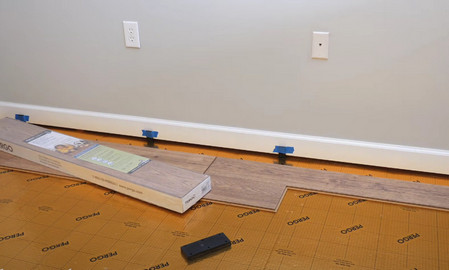How Much Weight Can Laminate Flooring Support
As homeowners, we often overlook the weight capacity of our flooring until it’s too late. Laminate flooring is a popular…
As homeowners, we often overlook the weight capacity of our flooring until it’s too late.
Laminate flooring is a popular choice for its affordability, durability, and aesthetic appeal. But how much weight can it support? Knowing the weight capacity of your laminate flooring is crucial, especially if you’re planning to place heavy furniture or appliances on it.
Laminate flooring is composed of several layers, including a high-density fiberboard core, a photographic layer, and a protective wear layer. Understanding the composition of laminate flooring is essential to determine its weight capacity.
In this article, we will delve into the factors that impact laminate flooring’s weight capacity, how to distribute weight evenly on the flooring, and tips for maintaining its strength and durability. So, let’s get started!
Understanding the Composition of Laminate Flooring
You’ll want to know what’s inside laminate flooring so you can better understand its structural limitations.
Laminate flooring is made up of four layers: the backing layer, the inner core layer, the design layer, and the wear layer.
The backing layer is made up of melamine, which provides support and stability to the flooring.
The inner core layer is made up of high-density fiberboard, which gives the flooring its strength and durability.
The design layer is where the aesthetic appeal of the flooring comes in, as it contains the printed image that mimics the look of wood, tile, or stone.
Lastly, the wear layer is a clear protective layer that helps prevent scratches, stains, and fading.
When it comes to laminate flooring installation, it’s important to note that the inner core layer is what gives the flooring its strength and durability.
This means that the flooring can support a certain amount of weight, but it does have its limitations.
The weight capacity of laminate flooring can vary depending on the thickness of the inner core layer and the overall quality of the flooring.
It’s recommended to always follow the manufacturer’s guidelines for weight restrictions when installing laminate flooring.
Proper laminate flooring maintenance is also important to ensure the flooring maintains its strength and durability.
Regularly sweeping or vacuuming the flooring can help prevent dirt and debris from scratching the wear layer.
Additionally, it’s important to clean up spills and stains immediately to prevent moisture from seeping into the inner core layer and causing damage.
By taking care of your laminate flooring and adhering to weight restrictions, you can ensure that your flooring lasts for years to come.
Determining the Weight Capacity of Laminate Flooring
Figuring out how much pressure your floors can handle is important, especially if you plan on hosting a lively game night or rearranging the furniture.
When it comes to laminate flooring, it has a weight capacity of 4,000 pounds per square inch (PSI). This means that it can easily support the weight of furniture, appliances, and other household items.
However, it’s important to note that the weight capacity of laminate flooring is affected by the flooring installation and furniture placement. When installing laminate flooring, it’s important to follow the manufacturer’s instructions and use the recommended underlayment. This helps distribute the weight evenly and prevent damage to the flooring.
Additionally, when moving heavy furniture, it’s important to lift and not drag it across the floor. Dragging furniture can cause scratches and dents, which can weaken the flooring’s weight capacity.
In summary, laminate flooring has a weight capacity of 4,000 PSI and can easily support the weight of furniture and household items. Proper flooring installation and furniture placement are important to maintain the weight capacity and prevent damage to the flooring. By following these guidelines, you can ensure that your laminate flooring will continue to support your household items for years to come.
Factors That Impact Laminate Flooring’s Weight Capacity
It’s crucial to consider the various factors that can affect the durability of your laminate floors and ensure that they can withstand the wear and tear of everyday life.
Installation methods play a significant role in determining the weight capacity of laminate flooring. Floors that are installed with a floating method have a lower weight capacity compared to those installed with a glue-down method. The latter provides more stability and strength, which makes it suitable for heavier loads.
Moisture levels are another factor that can impact the weight capacity of laminate flooring. High humidity levels can cause the planks to swell, making them more vulnerable to damage. This can affect the structural integrity of the floors and lead to a decrease in their weight capacity.
It’s essential to keep the moisture levels in check and avoid installing laminate flooring in areas with high humidity levels, such as bathrooms and kitchens.
In addition to installation methods and moisture levels, the thickness of the laminate flooring also plays a role in determining its weight capacity. Thicker laminate floors are more durable and can support heavier loads.
The thickness of the underlayment also affects the weight capacity of the floors. It’s crucial to choose a high-quality underlayment that can provide the necessary support and stability to the laminate flooring.
By considering these factors, you can ensure that your laminate floors can support the weight of your furniture and other heavy items without getting damaged.
Distributing Weight Evenly on Laminate Flooring
If you want to avoid damaging your brand new laminate floors, it’s important to distribute the weight of your furniture and other heavy items evenly. Weight distribution is critical in ensuring that your laminate flooring can support the weight of your furniture without causing any damage.
One way to distribute weight evenly is by placing furniture on top of plywood or foam padding. These materials help spread the weight of the furniture across a larger surface area, reducing the pressure on the laminate flooring.
Another way to distribute weight evenly on laminate flooring is by using furniture gliders. These small discs or pads are designed to be placed under the legs of furniture, making it easier to move heavy items without scratching the laminate flooring. Furniture gliders come in various sizes and materials, so it’s important to choose the right ones for your specific furniture and flooring.
Lastly, it’s essential to pay attention to furniture placement in your home. Avoid placing heavy items in high-traffic areas, as this can increase the risk of damage to your laminate flooring. Instead, place heavy furniture in areas where there is less foot traffic or on top of rugs or carpeting.
By following these tips, you can ensure that your laminate flooring can support the weight of your furniture and other heavy items without any damage.
Tips for Maintaining Your Laminate Flooring’s Strength and Durability
Maintaining your laminate floors’ strength and durability is easy with these helpful tips. Firstly, clean laminate flooring regularly to maintain its strength. Dirt and debris can accumulate on the surface and cause scratches or damage to the laminate. Use a soft-bristled broom or a vacuum with a soft brush attachment to clean your floors regularly. Avoid using abrasive cleaners or chemicals that may damage the surface.
Secondly, preventing scratches is essential for the longevity of your laminate flooring. One way to do this is to place felt pads on the bottom of furniture legs to prevent them from scratching the surface. Another way is to avoid wearing shoes with heels or hard soles on your laminate floors, as they can cause scratches. Also, be careful when moving heavy furniture or objects across the floor, as this can also cause scratches.
Lastly, maintaining a consistent environment is key to maintaining your laminate flooring’s strength and durability. Avoid exposing your flooring to extreme temperatures or humidity levels, as this can cause warping or damage. Use curtains or blinds to protect your floors from direct sunlight, as this can cause discoloration and fading over time.
By following these simple tips, you can ensure that your laminate flooring remains strong and durable for years to come.
Conclusion
So, to answer the question, “how much weight can laminate flooring support?” the answer is, it depends.
The weight capacity of laminate flooring varies depending on several factors such as its thickness, composition, and installation method. It is important to know the weight capacity of your laminate flooring to avoid any damage or accidents that may occur.
To maintain the strength and durability of your laminate flooring, it’s crucial to distribute the weight evenly across the surface. Avoid placing heavy furniture or appliances in one spot and instead spread them out across the room.
Additionally, regularly cleaning and maintaining your laminate flooring can help ensure its longevity and ability to support weight. By taking the necessary precautions and being mindful of the weight capacity, your laminate flooring can continue to provide a sturdy and reliable surface for years to come.



